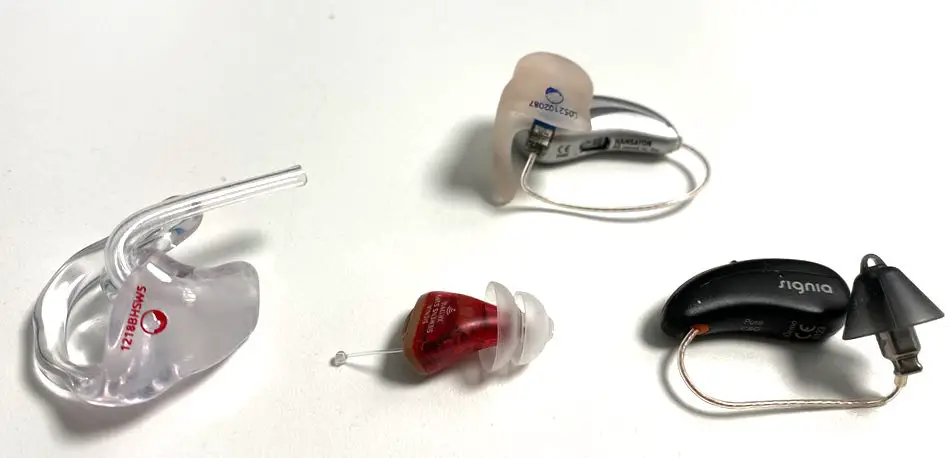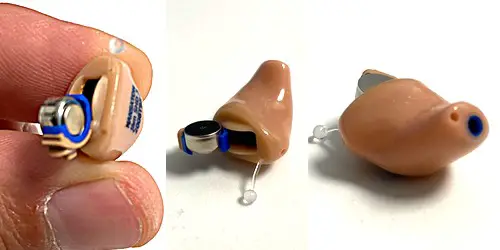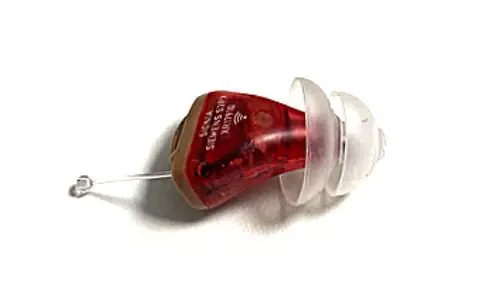When you are new to hearing aids you might wonder which hearing aid goes in which ear. Luckily hearing aids have blue or red parts which show you where to put them correctly. Red shows this hearing aid is for your right ear. Blue is for the left ear. Those parts are:
- The loudspeaker/receiver
- On the part of the behind the ear hearing aid which rests on your ear
- The custom earmold has usually something printed on it in blue or red
- The filter
- The battery case
When you look at the loudspeaker there is usually a red or blue sticker on them. As you can see in the picture below you can identify the hearing aids fairly easily. Every hearing aid here has a blue or red part or ink on it. The dark hearing aid on the right side of the picture shows the red color in a really subtle way. You can see it right there where the cable begins.

How Do I Know Which Hearing Aid Goes In Which Ear?
The side indication always refers to the view of the patient or customer and never to the view of the observer. So the right side is always the side where the customer would show his right ear.
As a rule, hearing aids are labeled by the hearing care professional. However, this marking is not always easy to find. If it is missing – ask your hearing care professional for a side label for hearing aids. When the part of the hearing aid which red or blue is fairly small an additional colored marker can be applied on the hearing aid to identify the side faster.

There is often a colored insert hidden in the battery case, a red insert in the device for the right ear, and a blue insert in the device for the left ear. The bottom/belly of hearing aids have also a spot that is popularly used for labeling the right and left sides. Fortunately, a hearing aid is not very large and the chance of finding the mark is very good.
In addition, the earpiece, the earmold, is now often color-coded as well. Usually, a number is engraved in the respective color.
With RIC hearing aids, color markings are present on the earpieces that go into the ear canal to prevent confusion, and with in-the-ear hearing aids, as with earmolds, laser engraving is favored.

For the smallest representatives in the hearing aid sector, the CIC and DIC devices, the entire housing, except for the outside (called faceplate), is usually manufactured in the matching color. You can look at an example in the picture above.
Now the SlimTube devices are still missing. Here there is a marking just before the dome on the tube. When you have a bigger dome just pull it away a little and the red or blue color will show on the end of the transparent tube.
What Color Hearing Aid Goes In the Right Ear?
The hearing aid with the red colored parts goes in the right ear. The hearing aid with the blue parts is for the left ear.
What if I Do Not See Colors on My Hearing Aid?
With no visible red or blue colors, it might be hard to tell which hearing aid goes in which ear. But you will figure it out easily with these instructions. Follow the instructions if you have a hearing aid with cables our tubes. When you have a behind the curves and shapes of the cables or tubes are designed to fit your ear without tension. Just place the hearing aids on top of your ear and look in the mirror.
When the end of the earmold or the domes are facing your head you placed each hearing aid correctly. You can now easily insert the domes or earmolds without any tension. When the domes or earmolds are facing away from you the sides need to be changed.
Because then you would have to twist the cable or tube heavily in order to be able to place the dome inside your ear canal. And of course this A not good for the parts of the hearing aid. But B it could damage your ear.
With in-ear hearing aids that are custom molded to your ear the shape can vary a lot. Usually when you place both in front of you it is possible to identify the outer and inner curve with each hearing aid. The part with the outer curve meets the part of the ear hole facing your face.
The part with the inner curve is facing the back of your head. In most cases with little in-ear hearing aids a little nylon thread is located on the bottom of the hearing aids. With the knowledge where the inner curve is and where the nylon thread should be placed you are now able to place each hearing aid in the correct ear.
I wish you a great day.
